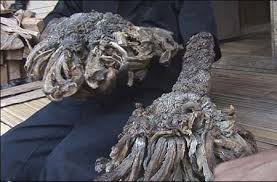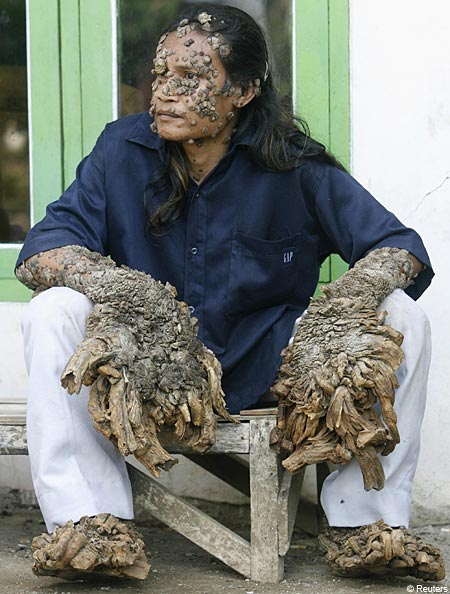Dede Koswara is a 35 year old fisherman in Indonesia. As a teenager, he cut his knee, and ever since then strange growths have covered his body. The growths on his hands and feet look especially like tree roots, and the large patches on his skin resemble the bark of a tree. As such, he’s simply called Tree Man.
Unsurprisingly, Dede has difficulty functioning, since he can’t use his hands and his feet are often a hindrance. He lost his job and his neighbors shunned him. His wife abandoned him, despite their two children. To support them, he began working at carnival freak shows, something you’d expect to see in a movie but that is, sadly, the truth of his life. Link Dede is thought to suffer from a tongue-twister of a disease known as Epidermodysplasia verruciformis.
What this means is that he has an abnormal susceptibility to human pappilomaviruses. Human pappilomaviruses (HPVs) are extremely easy to contract, and it has been suggested that up to 80% of people may be infected, though they show no symptoms. There are around 200 known types of HPV, but the majority have no noticeable affect. In rare instances, it can lead to certain forms of cancer, but the most common result of an HPV infection is your simple, everyday wart. Because of Dede’s body’s inability to stop the development of these growths on his skin, they have simply become larger and larger over time.
The hands and feet are especially vulnerable to HPV, and as such his “roots” have grown especially large there. For 20 years, the case has baffled doctors. While scientists understand the cause of his problem, nobody has been able to truly cure it yet. In 2007, Dede made international news when he hit the Internet and was featured in “My Shocking Story” on the Discovery Channel and TLC. (This show is “Extraordinary People” in the United Kingdom.) Later, in 2008, he was the subject of an episode of the popular program “Medical Mystery” as well.
Link Doctors in the United States believed they could treat Dede. However, officials from Indonesia’s Ministry of Health were hesitant to let him travel for treatment. Lily Sriwahyuni Sulistiyowati, the spokeswoman for the health ministry, stated that they were “clear about not giving [U.S. doctors] permission to bring Dede to the U.S.” She went on to elaborate: “Moreover, people like Dede, who live in small villages, don’t want to be taken away, especially to give blood samples.
Normally village people don’t easily give foreigners permission to test their blood.” After months of negotiations, Dede was finally treated. He underwent extensive surgery, and 13 lbs (6 kg) of overgrown warts were removed from his body. The surgery had three parts. Firstly, they removed the thick layer of wart tissue and the immense “roots” from his hands. Secondly, they removed the smaller patches of warts from the rest of his body. Thirdly, they grafted skin over his hands, where the skin was removed. The hope was that his growths would not return, or would at least return very slowly. Link This, sadly, was not the case.
Though 95% of his warts were removed, they grew back, and doctors estimated that it would take two surgeries a year for the rest of his life to keep them away. However, the surgery was far from a total failure. Though he will never be fully cured, Dede regained much functionality. He could feed himself, use a cell phone, and hold a pen, for example – all of which were things he could not do before.
From the hospital, he remarked: "What I really want first is to get better and find a job. But then, one day, who knows? I might meet a girl and get married." It’s reported that he has become a fan of Sudoku, since he can now hold a pen. A dermatologist in the United States has suggested that high doses of Vitamin A may help him keep the growths at bay by boosting his body’s ability to fight HPV, and talks were in place with pharmaceutical companies to keep him in high supply.
Dede’s case is probably the most extreme along these lines, but he’s not exactly alone in his affliction. In March 2007, a Romanian farmer named Ion Toader was also diagnosed with the condition. His pictures also frequently appeared in blogs and news stories for some time following his diagnosis, and his growths primarily affect his hands (which are not as extreme as Dede’s.) Another “tree man” was introduced to Dede 2009, who was even from the same region of Indonesia as him. Their meeting was documented in a Discovery Channel featured called “Treeman Meets Treeman”.
In another instance, an Indonesian man in Holland had the condition as well, and was treated with radiation therapy. The results were favorable in shrinking his growths, but unfortunately he developed cancer. It is not known for sure at this time precisely why this condition has affected men in Indonesia more than elsewhere.



No comments:
Post a Comment